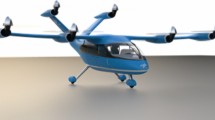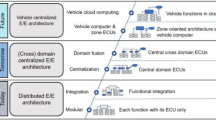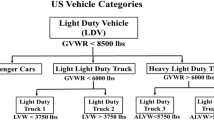Abstract
The ongoing global energy crisis and implementation of the “carbon peak, carbon neutrality” policy have increased drivers' propensity to drive energy efficiency. It is vital to model the energy-saving traffic flow phenomenon and find its energy consumption characteristics. This paper constructs the desired energy consumption speed model (a continuous function) for the first time. Next, an improved full-velocity difference model (E-FVDM) with the energy-saving coefficient is proposed to characterize the energy-saving traffic flow properties. Additionally, the E-FVDM stability condition is analyzed via linear stability theory. The numerical simulation findings demonstrate that traffic flow simulated by the E-FVDM has a smaller speed amplitude, a later congestion arrival time, and a lower congestion severity when compared to the full velocity difference model. The total energy consumption of the simulated traffic flow is reduced by up to 57% when employing the E-FVDM with a higher energy-saving coefficient. The average energy consumption evolves more quickly as the flow increases. When the energy-saving coefficient increases, the flow intensity of the following vehicle's total energy consumption to kinetic energy, air resistance energy consumption, and road frictional resistance energy consumption increase, while the flow intensity to the internal energy consumption of the vehicle drops. The phase transition features of the traffic flow states can be obtained in the energy intensity index curve of air resistance energy consumption. This study can offer technical assistance for reducing emissions and conserving energy in the transportation sector.







Similar content being viewed by others
Data availability
The datasets generated and analyzed during the current study are not publicly available but are available from the corresponding author on reasonable request.
References
IEA, World Energy Statistics and Balances, Paris, France: IEA (2021)
IEA, Greenhouse Gas Emissions from Energy, Paris, France: IEA (2021)
IEA, Energy Efficiency 2021, Paris, France: IEA (2021)
Cattin, J., Leclercq, L., Pereyron, F., Pereyron, N.E.: Calibration of Gipps’ car-following model for trucks and the impacts on fuel consumption estimation. IET Intell. Transp. Sy. 13, 367–375 (2019)
Jiao, S., Zhang, S., Zhou, B., Zhang, Z., Xue, L.: An extended car-following model considering the drivers’ characteristics under a V2V communication environment. Sustainability 12, 1552 (2020)
Tang, T., Yu, Q., Liu, K.: Analysis of the traffic running cost under random route choice behavior in a network with two routes. Physica A 449, 408–415 (2016)
Han, J., Wang, X., Wang, G.: Modeling the car-following behavior with consideration of driver, vehicle, and environment factors: A historical review. Sustainability 14, 8179 (2022)
Yu, S., Shi, Z.: An improved car-following model considering headway changes with memory. Physica A 421, 1–14 (2015)
Sun, D., Kang, Y., Li, H.: Analysis of evolution mechanism of traffic energy dissipation by considering driver’s forecast effect, Acta Phys. Sin.-Ch. Ed. 64, 347–353 (2015)
Peng, Y., Liu, S., Yu, D.Z.: An improved car-following model with consideration of multiple preceding and following vehicles in a driver’s view. Physica A 538, 122967 (2020)
Xiao, J., Ma, M., Liang, S., Ma, G.: The non-lane-discipline-based car-following model considering forward and backward vehicle information under connected environment. Nonlinear Dynam. 1229–1234, 2787–2801 (2022)
Zhao, M., Wang, S., Sun, D., Wang, X.: A car-following model considering preceding vehicle’s lane-changing process. IEEE Access 7, 89913–89923 (2019)
Yu, S., Liu, Q., Li, X.: Full velocity difference and acceleration model for a car-following theory. Commun. Nonlinear Sci. Numer. Simulat. 18, 1650069 (2013)
Li, T., Hui, F., Zhao, X.: An improved car-following model considering the impact of safety messages. Mod. Phys. Lett. B 32, 1850398 (2018)
Li, X., Luo, X., He, M., Chen, S.: An improved car-following model considering the influence of space gap to the response. Physica A 509, 536–545 (2018)
Jin, Z., Cheng, R., Ge, H.: Nonlinear density wave and energy consumption investigation of traffic flow on a curved road. Chinese Phys. B 26, 135–143 (2017)
Zhou, W., Zhang, J., Shi, Z., Liu, T.: A simplified full velocity difference model and its experimental verification. J. Northwest. Polytech. Univ. 31, 952–957 (2013)
Wang, J., Ding, J., Shi, Q., Kühne, R.D.: Lane-changing behavior and its effect on energy dissipation using full velocity difference model. Int. J. Mod. Phys. C 27, 1650013 (2016)
Wang, S., Li, Q., Fang, C., Zhou, C.: The relationship between economic growth, energy consumption, and CO2 emissions: Empirical evidence from China. Sci. Total Environ. 542, 360–371 (2016)
Ajeena, A.M., Víg, P., Farkas, I.: A comprehensive analysis of nanofluids and their practical applications for flat plate solar collectors: Fundamentals, thermophysical properties, stability, and difficulties. Energy Rep. 8, 4461–4490 (2022)
Yang, S., Deng, C., Tang, T., Qian, Y.: Electric vehicle’s energy consumption of car-following models. Nonlinear Dynam. 71, 323–329 (2013)
Awal, T., Kulik L., Ramamohanrao, K.: A k-leader fuel-efficient traffic model, In: 2013 IEEE Intelligent Vehicles Symposium, 2013, 1014–1021 (2013)
Tan, J., Gong, L., Qin, X.: Global optimality under internet of vehicles: Strategy to improve traffic safety and reduce energy dissipation. Sustainability 11, 4541 (2019)
Sun, B., Zhang, Q., Wei, N., Jia, Z., Li, C., Mao, H.: The energy flow of moving vehicles for different traffic states in the intersection. Physica A 605, 128025 (2022)
Jiang, R., Wu, Q., Zhu, Z.: Full velocity difference model for a car-following theory. Phys. Rev. E 64, 017101 (2001)
Li, Y., Zhong, Z., Zhang, K., Zheng, T.: A car-following model for electric vehicle traffic flow based on optimal energy consumption. Physica A 533, 122022 (2019)
Bando, M., Hasebe, K., Nakayama, A., Shibata, A., Sugiyama, Y.: Dynamical model of traffic congestion and numerical simulation. Phys. Rev. E Stat. Phys. Plasmas Fluids Relat. Interdiscip. Topics 51, 1035–1042 (1995)
Xu, X., Aziz, H.M.A., Liu, H., Rodgers M.O., Guensler R.,: A scalable energy modeling framework for electric vehicles in regional transportation networks, Appl. Energ., 269, 115095 (2020)
Wang, J., Besselink, I., Nijmeijer, H.: Electric vehicle energy consumption modelling and prediction based on road information. World Electr. Veh. J. 7, 447–458 (2015)
Funding
This work was supported by the National Real Science Foundation of China (42107114, 42177084), the Tianjin Science and Technology Plan Project (20YFZCSN01000) and the Fundamental Research Funds for the Central University of China (63221411).
Author information
Authors and Affiliations
Contributions
BS involved in writing—original draft, visualization, formal analysis, conceptualization, methodology, investigation, and data curation. QZ involved in writing—review and editing, supervision, and methodology. CZ involved in investigation and methodology. NW involved in investigation and methodology. ZJ involved in investigation and methodology. ZW involved in investigation and methodology. HM involved in supervision, resources, validation, and funding acquisition.
Corresponding authors
Ethics declarations
Conflict of interest
The authors declare that they have no known competing financial interests or personal relationships that could have appeared to influence the work reported in this paper.
Additional information
Publisher's Note
Springer Nature remains neutral with regard to jurisdictional claims in published maps and institutional affiliations.
Rights and permissions
Springer Nature or its licensor (e.g. a society or other partner) holds exclusive rights to this article under a publishing agreement with the author(s) or other rightsholder(s); author self-archiving of the accepted manuscript version of this article is solely governed by the terms of such publishing agreement and applicable law.
About this article
Cite this article
Sun, B., Zhang, Q., Zou, C. et al. Research on microscopic traffic flow modeling and energy characteristics in the energy-saving driving environment. Nonlinear Dyn 111, 14365–14378 (2023). https://doi.org/10.1007/s11071-023-08582-9
Received:
Accepted:
Published:
Issue Date:
DOI: https://doi.org/10.1007/s11071-023-08582-9




